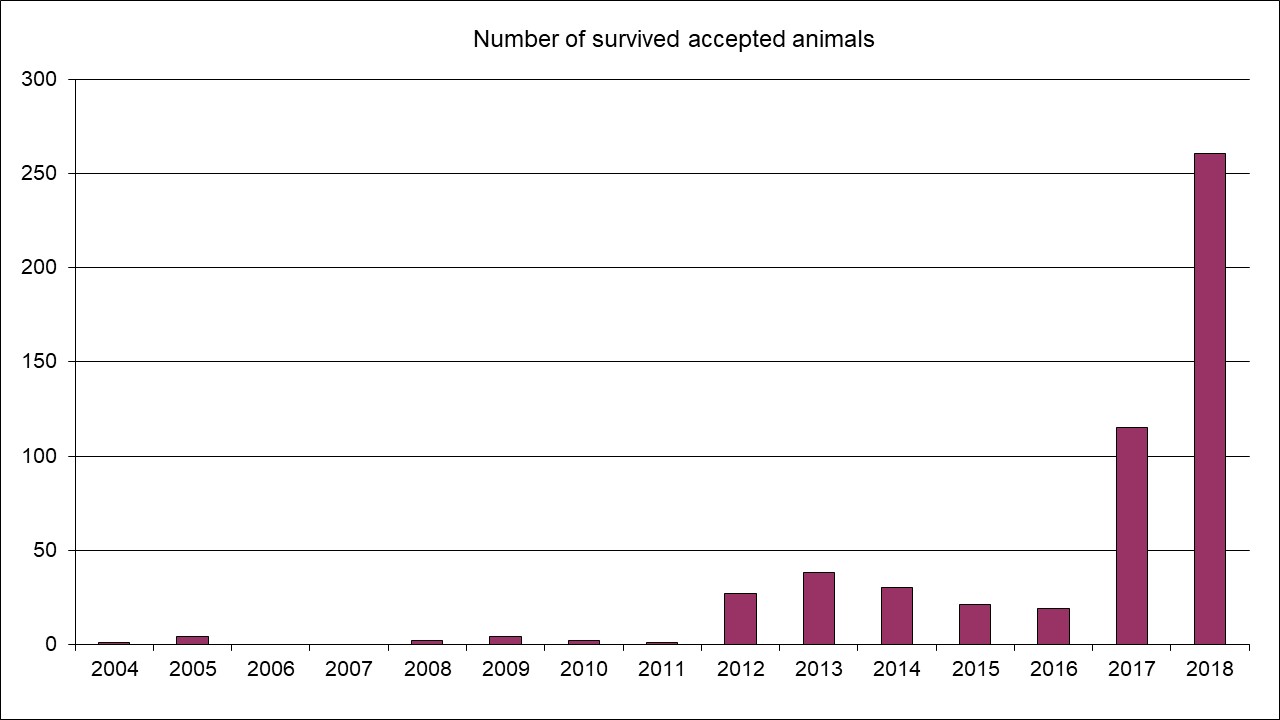Key message: The number of animals in the zoo shelter is increasing; the most endangered species are birds
Assessment: Zoo Palić officially started cooperation with competent institutions for appropriate disposal and care for seized or confiscated wildlife in 2004. First live specimens from the confiscation received at the shelter were three specimens of Green iguana (Iguana iguana) and one specimen of Burmese python (Python molurus). Up to date, more than 3,500 animals have been accepted in the shelter, and the tendency of the arrival of individuals is increasing each year.
The structure of seized or confiscated live specimens of wild animals shows that birds and reptiles were the most numerous animals in the Zoo, followed by mammals.
Half of the specimens that disposed in the shelter of Zoo Palić were brought by citizens, and other half were specimens that are under some regime of protection. Usually they were in bad medical condition (injured, sick, fell out of the nest). In cooperation with the institutes for nature conservation, each year around 30% of individuals are successfully marked and returned to nature. Around 30% of individuals are retained each year in the shelter since in need for extended rehabilitation or in need to resolve their legal status, due to pending court decision. Individuals of the most exotic species were confiscated in the cooperation between customs, police, border police, environmental inspection, veterinary inspection and communal police, all under the supervision of the Ministry of Environment, which is also the legal authority for functioning of the care of animals. The Zoo uses all its free capacities for care of confiscated animals in separate compartments in the area not visible to visitors. However, in cases where no other options are available, other capacities are also used, as was the case of the recently disposed iguanas and giant snakes, or in case of confiscation of the bears from circus (http://mondo.rs/a689997/Info/Drustvo/Tri-meceta-odlaze-iz-Srbije-u-Rumuniju.html). In the last two years, significant cooperation with the Provincial Institute for Nature Conservation has been achieved, and over 40 birds have been released within these programmes (https://vojvodinainfo.rs/palic-vetruske-iz-zoo-vrta-vracene-u-prirodu/), as well as during the week of promotion of CITES, which was seen by over 200 children. (http://zoopalic.com/obelezen-dan-divljih-vrsta-cites-konvencija/).

Indicator Name: Number and structure of animals in the shelter of Zoo Palic
Institution/Author: Environmental Protection Agency/Slaviša Popović, Ministry for Environmental Protection/Pavle Jovanović, Zoo garden Palic/Kristijan Ovari
Use and interpretation:
The Palić Zoo officially started cooperation with the competent institutions for appropriate disposal and care for seized or confiscated wildlife in 2004. First live specimen from the confiscation arrived at the shelter were three specimens of Green iguana (Iguana iguana) and one specimen of Burmese python (Python molurus).
Potential for aggregation:
Up to date, more than 3,500 animals have been accepted in the shelter, and the tendency of the arrival of individuals is increasing each year.
Possible reasons for upward or downward trends: The structure of seized or confiscated live specimens of wild animals shows that birds and reptiles were the most numerous animals in the Zoo, followed with mammals.
Implications for biodiversity management of change in the indicator:
Around 30 % of individuals are retained each year in the shelter since in need for extended rehabilitation or in need to resolve their legal status, due to pending court decision. Individuals of the most exotic species were confiscated in the cooperation between customs, police, border police, environmental inspection, veterinary inspection and communal police, all under the supervision of the Ministry of Environment, which is also the legal basis for the functioning of the care of animals.
Units in which it is expressed:
Number of cases and number of individuals.
Description of source data:
The Palić Zoo, Ministry of Environmental Protection of the Republic of Serbia
The Zoo uses all its free capacities for confiscated animals care in separate compartments in the area not visible to visitors. However, in cases where no other options are available, other capacities are also used, as was the case of the recently disposed iguanas and giant snakes, or in case of confiscation of the bears from circus (http://mondo.rs/a689997/Info/Drustvo/Tri-meceta-odlaze-iz-Srbije-u-Rumuniju.html) In the last two years, significant cooperation with the Provincial Institute for Nature Conservation has been achieved and over 40 birds have been released in the framework of these programs (https://vojvodinainfo.rs/palic-vetruske-iz-zoo-vrta-vracene-u-prirodu/), as well as during the week of promotion of CITES, which was seen by over 200 children (http://zoopalic.com/obelezen-dan-divljih-vrsta-cites-konvencija/).
Calculation procedure:
(include appropriate methods and constraints for aggregation):
Half of the specimens that are disposed in the shelter of the Palić Zoo were brought by citizens, and other half were specimens that are under some regime of protection. Usually they were in bad medical condition (injured, sick, fell out of the nest). In cooperation with the institutes for nature conservation each year around 30 % of individuals are successfully marked and returned to nature.
Most effective forms of presentation:
Graph.
Limits to usefulness and accuracy:
No limits.
Updating the indicator:
Once a year.
Closely related indicators
Additional information and comments
Table: Number and structure of animals in the shelter of Zoo Palic
| 2004 | 1 |
| 2005 | 4 |
| 2006 | |
| 2007 | |
| 2008 | 2 |
| 2009 | 4 |
| 2010 | 2 |
| 2011 | 1 |
| 2012 | 27 |
| 2013 | 38 |
| 2014 | 30 |
| 2015 | 21 |
| 2016 | 19 |
| 2017 | 115 |
| 2018 | 261 |
Serbia